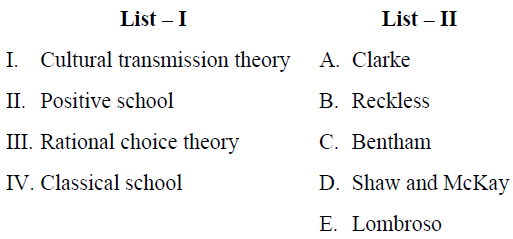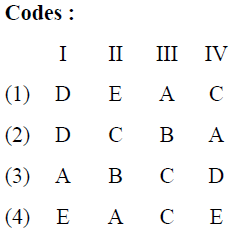CRIMINOLOGY
Paper – II
Note : This paper contains fifty (50) objective type questions of two (2) marks each. All questions are compulsory.
1. How many subjects were there in the study, ‘The English Convict’, by Charles Goring ?
(1) 3000 English Convicts
(2) 4000 Italian Convicts
(3) 5000 American Convicts
(4) 7000 German Convicts
2. Indicate using the codes, who among the following one linked to white collar crimes ?
I. Politicians
II. Professionals
III. Office WorkersIV. P
eople with Social Status
Codes :
(1) I is true
(2) II & III are true
(3) II and IV are true
(4) I and III are true
3. Which radical criminology view is primarily concerned with restorative justice for communities, victims and offenders ?
(1) Conflict theory
(2) Left realism perspective
(3) Abolitionist criminology
(4) Peace-making criminology
4. The physiological or medical removal of toxic substances from a human body is called
(1) Rejuvenation
(2) Retoxification
(3) Detoxification
(4) Restoration
5. Which of the following is not correctly matched ?
(1) Worm – Cyber crime
(2) Insurgency – Tamil Nadu
(3) White collar crime – Professionals
(4) Cannot contest election – Convicted person
6. Indicate, using the codes given below, which among the following is linked to cyber crimes ?
I. Worms
II. Virus
III. Foreign exchange
IV. Denial of service
Codes :
(1) I & II are correct
(2) II and III are correct
(3) I, II and III are correct
(4) I, II and IV are correct
7. Which of the following practical issues should be considered before doing the criminological research ?
I. Access to information
II. Cost of Research
III. Time required to do research
IV. The availability of the information
Codes :
(1) I, II, III and IV are correct
(2) II, I, III and IV are correct
(3) III, II, I and IV are correct
(4) I, III, II and IV are correct
8. Who among the following opined the view that “society is organic body and crime is the disease” ?
(1) Goddard
(2) Sheldon
(3) Kretchmer
(4) Garofalo
9. Which section of the Indian Evidence Act deals with that “confession by accused while in custody of police cannot be proved against him ?
(1) Section 26
(2) Section 21
(3) Section 23
(4) Section 22
10. Which section defines the ‘Juvenile’ in Juvenile Justice (Care and Protection of Children) Act 2015 ?
(1) Section 2(10)
(2) Section 2(15)
(3) Section 2(25)
(4) Section 2(35)
11. How would you classify ‘desertion’ by a husband from his family ?
(1) Violation of contract
(2) Social problem
(3) Crime
(4) None of the above
12. Assertion (A) : Differential Reinforcement theory is an attempt to explain crime as a type of learned behavior.
Reason (R) : A number of learning processes shape behavior and direct conditioning occurs when behavior is reinforced by being either rewarded or punished while interacting with others.
(1) Both (A) and (R) are true and (R) is correct explanation of (A).
(2) Both (A) and (R) are true, but (R) is not the correct explanation of (A).
(3) (A) is true, but (R) is false.
(4) (A) is false, but (R) is true.
13. Assertion (A) : Crime is considered to be a function of free will and personal choice. Punishment on the other hand, is a deterrent to crime.
Reason (R) : Crime is seen as a function of upbringing, learning, and control Peers, parents and teachers influence behaviour.
(1) Both (A) and (R) are true and (R) is correct explanation of (A).
(2) Both (A) and (R) are true, but (R) is not the correct explanation of (A).
(3) (A) is true, but (R) is false.
(4) (A) is false, but (R) is true.
14. Assertion (A) : The combination of cooperative surveillance and willingness to intervene has been called protective neighbouring.
Reason (R) : Protective neighbouring seems to be more common among people with higher incomes, among long term residents and among home owners.
(1) Both (A) and (R) are true.
(2) Both (A) and (R) are false.
(3) (A) is true, but (R) is false.
(4) (A) is false, but (R) is true.
15. Assertion (A) : Punishment is the defining characteristic of crime and other characteristics such as social harm are corollaries rather than defining traits.
Reason (R) : The law requires a causal connection among criminal intent, criminal conduct and harm to prove the guilty mind then determine the suitable punishment.
(1) Both (A) and (R) are true.
(2) Both (A) and (R) are false.
(3) (A) is true, but (R) is false.
(4) (A) is false, but (R) is true.
16. The term ‘Status Offence’ is related to
(1) Political Crime
(2) White Collar Crime
(3) Economic Offences
(4) Juvenile Delinquency
17. Who among the following is the proponent of “Differential Identification Theory” ?
(1) Simon Dinitz
(2) Paul Tappan
(3) Robert Agnew
(4) Daniel Glacer
18. There has been an “Institutionalised racism” against Afro-Americans and hence there is a discriminatory approach by police. Whose view is this ?
(1) Feminist Criminologists
(2) Environmental Criminologists
(3) Positive Criminologists
(4) Critical Criminologists
19. How many Central Jails are there in India ?
(1) Between 110 to 120
(2) Between 121 to 130
(3) Between 131 to 140
(4) Between 141 to 150
20. A tentative explanation based on theory to predict a causal relationship between two or more variables is called
(1) Reliability
(2) Framework
(3) Internal validity
(4) Hypothesis
21. The most frequented score in a statistical distribution is called
(1) Reliability
(2) Dispersion
(3) Mode
(4) Mean
22. The collection of information from all units in a defined universe is called
(1) Ceiling
(2) Sample
(3) Census
(4) Case study
23. In case of information relating to the cognizable offence, it shall be reduced to writing under section :
(1) 154 of Cr. P.C.
(2) 165 of Cr. P.C.
(3) 149 of Cr. P.C.
(4) 150 of Cr. P.C.
24. Which statistical measure indicates the degree to which two or more variables are related with each other ?
(1) Standard Deviation
(2) Correlation coefficient
(3) Central tendency
(4) Discriminant Analysis
25. Crimes such as robbery, dacoity, murder and rape are considered as :
(1) Actus delicti
(2) Mala in se
(3) Mala prohibitum
(4) All the above
26. During prosecution in a court of law in India the benefit of doubt goes in favour of :
(1) Victim
(2) Prosecutor
(3) Accused
(4) Complainant
27. Match List – I with List – II, using the codes given below :


28. Which among the following is not a “Graphic representation” ?
(1) Pie Chart
(2) Tables
(3) Bar Chart
(4) Histogram
29. Which among the following are offence against human body ?
(1) Culpable Homicide
(2) Murder
(3) Dowry death
(4) All of the above
30. Who has indicated a correlation between crime and heredity ?
(1) Cesare Beccaria
(2) Enrico Ferri
(3) Cessare Lombroso
(4) Charles Goring
31. Who has propounded Social Bonding theory ?
(1) Cessare Lombroso
(2) Walter Reckless
(3) Travis Hirshi
(4) Howard Becker
32. Who propounded Institutional Anomic theory ?
(1) Harold E. Pepinsky and Richard Quinney
(2) Sutherland and Cressey
(3) Shaw and Mckay
(4) Messner and Rosenfeld
33. Which sampling is best to study habitual drug users ?
(1) Simple Random Sampling
(2) Snow-ball Sampling
(3) Cluster Sampling
(4) Stratified Random Sampling
34. Who has introduced the concept of ‘Criminal Saturation’ ?
(1) W. Bonger
(2) R. Garofalo
(3) E. Ferri
(4) G. Tarde
35. The idea that humans have mental conflicts because of desires and urges are repressed into the unconscious is propounded by
(1) Henry Goddard
(2) Eysenck
(3) Sigmund Freud
(4) Bandura
36. In the process of conducting research “Formulation of Hypothesis” is followed by
(1) Selection of Research tools
(2) Statement of objectives
(3) Collection of Data
(4) Analysis of Data
37. According to The Juvenile Justice (Care and Protection of Children) Act (JJ Act) how many woman social workers should be there in Juvenile Justice Board ?
(1) Atleast one
(2) Atleast two
(3) Atleast three
(4) None of the above
38. Assertion (A) : Information in regards to a cognizable offence is recorded as an FIR.
Reason (R) : Information with regards to non-cognizable offence is filed as Daily Diary Report. (DDR).
(1) (A) is right, but (R) is wrong.
(2) (A) is wrong, but (R) is right.
(3) Both (A) and (R) are right.
(4) Both (A) and (R) are wrong.
39. Who is competent to grant prisoners admission to open-air jail ?
(1) Police
(2) Judiciary
(3) Jail Authorities
(4) Probation Officer
40. Criminal victimization survey in the USA highlights
(1) Reported crimes
(2) Hidden crimes
(3) Victimless crimes
(4) All the above
41. ‘Victim Precipitation Theory’ was propounded by
(1) Marvin Wolfgang
(2) Benjamin Mendelsohn
(3) Ronni Netal
(4) Walter Reckless
42. ‘Mala-in-se’ means
(1) Insistent wrong
(2) Inherent wrong
(3) Immediate wrong
(4) Indebted wrong
43. In Ramamurthy v/s State of Karnataka the Supreme Court of India has given direction for
(1) Juvenile Justice Reforms
(2) Prison Reforms
(3) Judicial Reforms
(4) Police Reforms
44. Dealing with victim’s needs, assistance and participation is called
(1) Victim Advocacy
(2) Offender Advocacy
(3) Elders Advocacy
(4) Political Advocacy
45. After Independence, welfare state constituted jail reform committees to improve the jail conditions. Indicate the committees constituted chronologically.
I. Justice Krishna Iyer Committee on women prisoners.
II. Dr. W.C. Reckless Committee prison administration in India.
III. All India Jail Manual Committee.
IV. All India Committee on Jail Reform (Mulla Committee)
Codes :
(1) IV, III, II, and I are correct
(2) II, III, IV and I are correct
(3) I, II, III and IV are correct
(4) IV, I, II and III are correct
Read the following passage and answer the questions 46 to 50 :
Fear can contribute to crime by undermining community solidarity and weakening informal social control. Fear is not always rationally related to the actual risk of victimization. It causes people to stay at home, restrict their travel and spend money on measures which will protect them from crime. By reducing interpersonal trust, fear can diminish the informal control of behaviour in a community. Informal control of crime is most effective when interaction is common. Those conditions are more common in small towns than in large cities.
46. In your opinion this paragraph speaks about :
(1) Crime prevention
(2) Defensible space
(3) Fear of crime
(4) Housing plans
47. What effect does Fear, have on community solidarity ?
(1) Increasing effect
(2) Minimum effect
(3) Routine effect
(4) No effect
48. According to the above paragraph, how is fear related to crimes ?
(1) Positively related
(2) Negatively related
(3) Always related
(4) Not related at all
49. What causes people to stay at home ?
(1) Fear of solidarity
(2) Fear of spending money
(3) Fear of travel
(4) Fear of crime
50. Fear has an inverse relationship with
(1) Interpersonal trust
(2) Crime rates
(3) Victimization rates
(4) Increasing informal control
Latest Govt Job & Exam Updates: